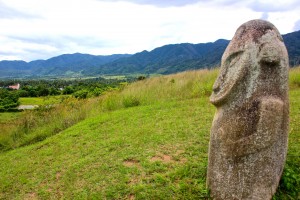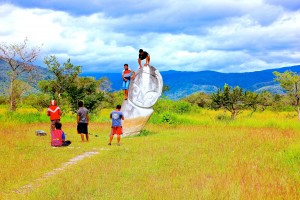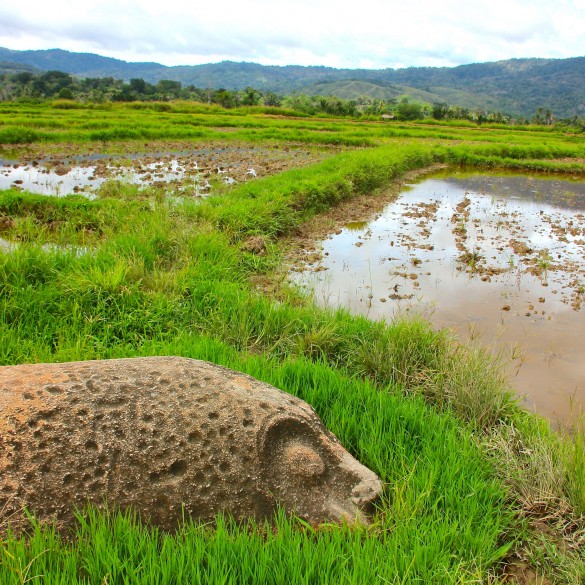The Bada, Napu, and Doda Valleys of Central Sulawesi’s vast Lore Lindu National Park are perhaps most famous for the ancient monolithic human figures (arca) similar to the mo’ai of Easter Island. A visit to the valleys to see these changed my perspective on Indonesian history.
Bada Valley is about a two-hour drive from Tentena, a small town by the shores of Lake Poso, Indonesia’s third-deepest lake. The air turned noticeably cooler as the shared car entered the highlands, only to break down midway. The rugged serpentine road made me nervous enough to reach for seat belts. Not long after we got help and the car’s engine started, we saw another car upside down in the deep ditch just off the road – the driver said it fell the night before while trying to navigate the dark.
I was surprised that my smartphone had full mobile network coverage as we entered Bada. “We just got it last year,” said a local.
I stayed at Losmen Immanuel in Gintu village, the administrative capital of Bada Valley. I walked with an American backpacker I met in Tentena, JK, to the neighbouring village of Bewa. “Hello, Mister,” the village kids would greet us. By the village roundabout decorated by a monolithic figure, we hired ojek to take us to the nearest arca.
The hills the ojeks took us to flaunted a 180° view of Bada Valley, with green meadows and lush gardens framed by blue mountains. “Tell the ojek this has been one of the most beautiful views I’ve seen in Southeast Asia,” said JK. A smiling monolith with clenched fists looks out to the view.
We then rode towards Bomba to see another small monolithic woman among abandoned traditional houses. Nobody knows much about the story behind these houses and its watchwoman of stone. As the sun set, JK told me his travel tales of getting high with indigenous community leaders at an ancient Mexican monument. We walked through rice fields and spotted each village’s stained glass churches, still ornate with Christmas decorations. “I’m amazed that in a place as remotely Eastern as this Bada Valley, people still have such a westernised image of Jesus,” remarked JK.
The next morning, we followed local guide Sjuman to To-Manuru, a fenced, decapitated figure and another obscured arca that blends in with the fence. The monolith in the centre used to be the guardian of a banyan tree, but now a ketapang tree is in its place. To-Manuru was believed to be the ancestral god-incarnate from heaven. The arcas sit right by a village junction, and a nearby church was preparing the evening’s New Year’s Eve service. A stone on the ground had an eye on it.

“Like most Bada arcas, this site is between 2,000-2,500 years old,” said Sjuman. “This commemorates the ancient village of Tinoi, which has now blended into the surrounding forests.”
“Sounds sacred. How come we could just climb this fence and there’s much litter around?” I asked.
“It is a sacred and historical place, but at the same time it’s also right here in the village where we carry about our day-to-day business,” Sjuman explained. “This used to be the war grounds of the Bada and Kulawi tribes. We fought wars just to show neighbouring tribes who was boss around here, until the Dutch came and shared the Gospel of Jesus Christ among us.”
“Who are your best-remembered war heroes? Did any of them fight the Dutch for Indonesia’s independence?” I asked.
“Nobody fought the Dutch. They came not with soldiers but missionaries, so they taught us how to love our neighbours and brought peace upon Lindu,” he replied.
We spent midday walking some vast rice fields. Dodging hidden potholes on the barely-there paths, I wondered what was so special about this place. Sjuman then pointed to a large rock in the middle of the padi field. But it wasn’t just a rock – it had a prominent bug-eyed face sculpted on it. Locals call it Watu Baula, the 2,200-year-old buffalo rock.
“When I was a teenager in the 1970s, I used to help my father sell fruits in Tentena. There were no cars so we walked and had a horse carry our load. A return journey took three days. My mother would prepare cooked food in hollow bamboo for us to carry, and at night we slept by the roadside,” Sjuman reminisced of his youth as we rested in a nearby gazebo.
After lunch, we made it to Padang Sepe to see the iconic 4.5-metre Watu Palindo. Slanted like the Tower of Pisa, locals believe grazing cattle centuries ago enjoyed pushing against it. A group of teenage boys were climbing the gigantic arca and taking photos when we arrived.


“That monolith will be so damaged after the thousandth climber. Why isn’t there anyone in charge here to keep them away from it? Why isn’t your government doing something about it?” asked JK, obviously irritated.
Sjuman said something about the Government not having the money or proper manpower. I pondered over JK’s question in silence. I used to think I wanted to promote tourism in Indonesia so that the Government can raise funds and proper manpower to make nice museums, tourism facilities, and souvenir shops that empower locals with economic opportunities. But being in Bada Valley made me realise something more important – people here live among 2,500 years of history, right in their midst. They don’t have to dress up and buy tickets to some fancy museum and spend money on expensive coffee or souvenirs to have this experience – it’s right there in their backyards. And I’m beginning to wonder if “proper tourism” would take this away from the people of Bada.
That night, being strangers in town with no one to visit, JK and I had the honour of visiting Sjuman in his family’s home for dinner. There, we watched the humble villages of Bada Valley light up with fireworks at midnight as we welcomed the New Year.
FAST FACTS
Country: Indonesia
Province: Sulawesi Tengah (Central Sulawesi)
Land area: Lore Lindu National Park – 2179.912 km2
Largest city: Poso
Population: 209,252 – 2010 estimate of Poso regency
How to get there: Wings Air flies to Poso from Makassar. 4 hours drive from Poso to Tentena, 2 hours drive from Tentena to Bada Valley
What to bring: Hat, sunglasses, sunscreen lotion, camera, raincoat, trekking shoes, a warm sweater for evenings




